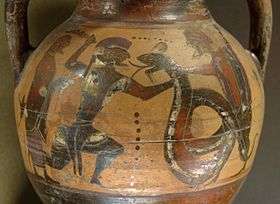Chthonic
| Greek mythology |
|---|
 |
| Deities |
|
|
| Heroes and heroism |
|
| Related |
|
|
| Greek deities series |
|---|
| Chthonic deities |
Chthonic (UK /ˈkθɒnɪk/, US /ˈθɒnɪk/ from Greek χθόνιος khthonios [kʰtʰónios], "in, under, or beneath the earth", from χθών khthōn "earth")[1] literally means "subterranean". The translation of meaning discusses deities or spirits of the underworld, especially in Greek religion. The Greek word khthon is one of several for "earth"; it typically refers to the interior of the soil, rather than the living surface of the land (as Gaia or Ge does), or the land as territory (as khora (χώρα) does).[2]
Chthonic and Olympian
Chthonic, which is a form of khthonie and khthonios, has a precise technical meaning in Greek, referring primarily to the manner and method of offering sacrifices to specific deity or deities, generally referred to as chthonic or chthonian deities. These include but are perhaps not strictly limited to Demeter and Hades in classical mythology.
Some chthonic cults practised ritual sacrifice, which often happened at night. When the sacrifice was a living creature, the animal was placed in a bothros (βόθρος, "pit") or megaron (μέγαρον, "sunken chamber"). In some Greek chthonic cults, the animal was sacrificed on a raised bomos (βωμός, "altar"). Offerings usually were burned whole or buried rather than being cooked and shared among the worshippers.[3]
Cult type versus function
The myths associating the underworld chthonic deities and fertility were not exclusive. Myths about the later Olympian deities also described an association with the fertility and the prosperity of Earth. Thus Demeter and Persephone both watched over aspects of the fertility of land, yet Demeter had a typically Olympian cult while Persephone had a chthonic one.
Also, Demeter was worshiped alongside Persephone with identical rites, and yet occasionally was classified as an "Olympian" in late poetry and myth. The absorption of some earlier cults into the newer pantheon versus those that resisted being absorbed is suggested as providing the later myths.
Ambiguities in assignment
The categories Olympian and chthonic were not, however, completely separate. Some Olympian deities, such as Hermes and Zeus, also received chthonic sacrifices and tithes in certain locations. The deified heroes Heracles and Asclepius might be worshipped as gods or chthonic heroes, depending on the site and the time of origin of the myth.
Moreover, a few deities are not easily classifiable under these terms. Hecate, for instance, was typically offered puppies at crossroads—a practice neither typical of an Olympian sacrifice nor of a chthonic sacrifice to Persephone or the heroes. Because of her underworld roles, Hecate is generally classed as chthonic.
References in psychology and anthropology
In analytical psychology, the term chthonic was often used to describe the spirit of nature within; the unconscious earthly impulses of the Self, that is one's material depths, however not necessarily with negative connotations, see also anima and animus or shadow.
As well, the chthonic has connotations with regard to gender, in cultural anthropology; del Valle's Gendered Anthropology describes there being "male and female deities at every level... men associated with the above, the sky, and women associated with the below, with the earth, water of the underground, and the chthonic deities."[4] This was by no means universal; in Ancient Egypt the main deity of the earth was the male god Geb, his female consort was Nut, otherwise known as the sky.[5] Greek mythology likewise has female deities associated with the sky, such as Dike, goddess of justice who sits on the right side of Zeus as his advisor, and Eos, goddess of dawn—and Hades as god of the underworld.
References in structural geology
The term Allochthon in structural geology is used to describe a large block of rock which has been moved from its original site of formation, usually by low angle thrust faulting. From the Greek "allo" meaning other and "chthon" designating the process of the land mass being moved under the earth and connecting two horizontally stacked décollements and thus "under the earth".[6]
See also
References
- ↑ Chthonios, Henry George Liddell, Robert Scott, A Greek–English Lexicon, at Perseus.
- ↑ source=name"Introduction to Cthhonic"/source
- ↑ "The sacrifice for gods of the dead and for heroes was called enagisma, in contradistinction to thysia, which was the portion especially of the celestial deities. It was offered on altars of a peculiar shape: they were lower than the ordinary altar bomos, and their name was ischara, 'hearth'. Through them the blood of the victims, and also libations, were to flow into the sacrificial trench. Therefore they were funnel-shaped and open at the bottom. For this kind of sacrifice did not lead up to a joyous feast in which the gods and men took part. The victim was held over the trench with its head down, not, as for the celestial gods, with its neck bent back and the head uplifted; and it was burned entirely." (Source The Heroes of the Greeks, C. Kerenyi pub. Thames & Hudson 1978).
- ↑ Teresa del Valle, Gendered Anthropology, Routledge, 1993, ISBN 0-415-06127-X, p. 108.
- ↑ Geraldine Pinch, "Handbook of Egyptian Mythology"' ABC-CLIO, ISBN 1-57607-242-8, p. 135.
- ↑ DiPietro, Joseph A. (December 21, 2012). Landscape Evolution in the United States: An Introduction to the Geography, Geology, and Natural History. Newnes. p. 343. ISBN 9780123978066. Retrieved 10 February 2016.
External links
-
 The dictionary definition of chthonic at Wiktionary
The dictionary definition of chthonic at Wiktionary